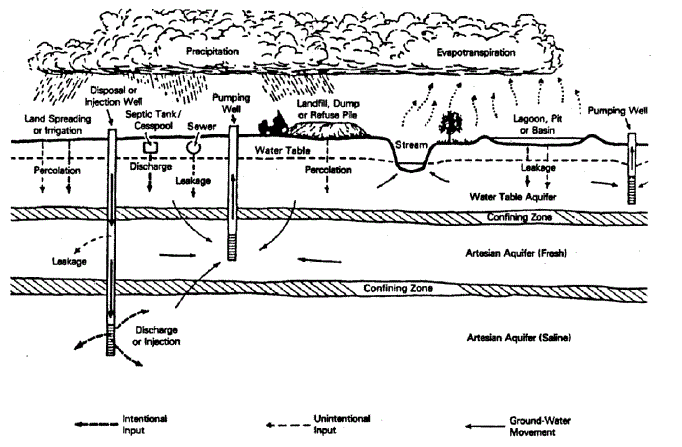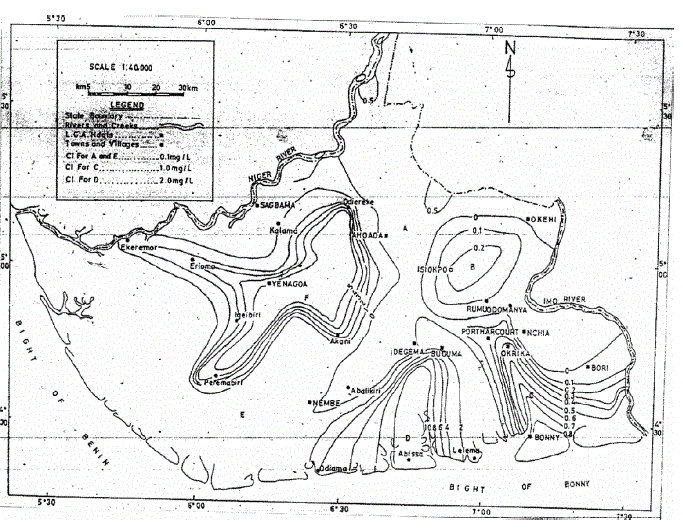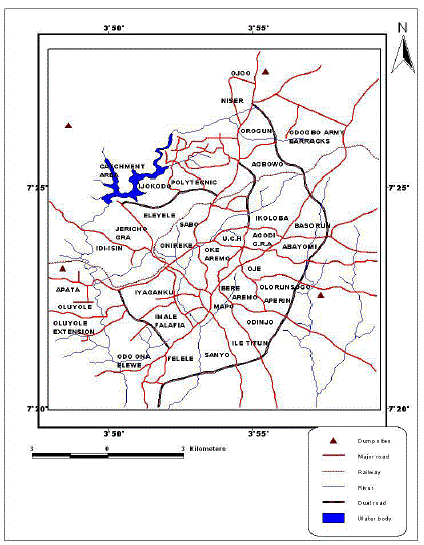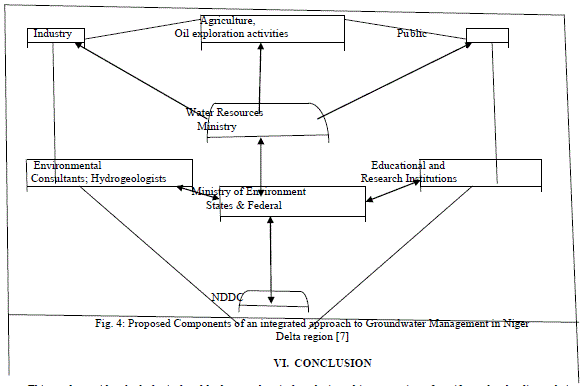ISSN ONLINE(2319-8753)PRINT(2347-6710)
ISSN ONLINE(2319-8753)PRINT(2347-6710)
|
Awajiogak, Anthony Ujilea Senior Lecturer, Head of Department, Department of Chemical/Petrochemical & Petroleum Engineering, Rivers State University of Science and Technology, P.M.B. 5080, Port Harcourt, NIGERIA |
| Related article at Pubmed, Scholar Google |
Visit for more related articles at International Journal of Innovative Research in Science, Engineering and Technology
This paper details the natural phenomena and anthropogenic activities which constitute threat to the integrity of groundwater resource in towns and villages in parts of Nigeria. Parts of Niger Delta and Ibadan were considered in this study. High iron loadings from Itakpe Iron ore deposits are transferred by migration, inter aquifer exchange; absorption/adsorption processes, ion exchange to contaminate ground water in parts of Niger Delta. Salt water intrusion is enhanced by high level of industrialization (which has brought in dredging works, crude oil exploration and exploitation, complex foundation works for the construction of surface facilities). Crude oil spillages and petroleum product seepage from storage facilities contribute to groundwater pollution problems. Poor and improper waste management systems have constituted a menace to groundwater aquifer. Processes that tend to retard the rate of contaminant migration and act as mechanisms for concentration attenuation have been considered. Remediation methods and Best Management Practices (BMPs) involving integrated approach have been proposed in this paper to be applied to provide not only sufficient potable water but also reliable quality in the study areas.
Keywords |
| Leachate, porous media, advection, dispersion |
INTRODUCTION |
| Increasing population and higher levels of human activities, including effluent disposals to surface and groundwater sources, have made sustainable management of water resources a very complex task throughout the world. In addition, per capita demand for water in most countries is steadily increasing as more and more people achieve higher standards of living and as lifestyles are changing steadily. Groundwater has always been considered to be readily available source of water for domestic, agricultural and industrial use. Groundwater extracted for variety of purposes has made a major contribution to the improvement of the social and economic circumstances of humans. However, with increase in demand, this resource is being overexploited in many areas, resulting in permanent depletion of the aquifer system and associated environmental consequences such as land subsidence and water-quality deterioration. The challenges of groundwater quality and quantity have captured the attention of some authorities who have concern for planning and policymaking for the utilization of groundwater. However, in Nigeria the trend is different. This is corroborated from Table 1.0 which shows that Nigeria, whose population is expected to increase significantly from about 108 million in 1994 to some 339 million by the year 2050, its per capita water availability is likely to decline from 2870 m3/year to only 910 m3/year by 2050 (United Nations Report) [1]. While this is likely to be the global trend in the future, there would be some exceptions in a few countries such as Japan, whose total population is likely to decline modestly during this period. |
 |
| The study of groundwater, in particular, where environmental implications are important is a multidisciplinary activity encompassing scientific, engineering, and economic considerations based on proper conceptualization of the functioning of the physical system followed by a detail quantitative analysis [2]. With an introduction on the characteristics of groundwater flow, groundwater use, and the role of groundwater in the water-resource system, an elaboration on environmental issues and environmental assessment is provided. This requires a detail hydro-geological data collection, analysis and evaluation of groundwater resource to be performed in an integrated manner (with feedback between activities) with proper direction to the objectives to be achieved for a particular area (system). This presentation therefore considers two areas; Iron loadings in Rivers/Bayelsa States and effects of improper solid wastes disposal in Ibadan metropolis on groundwater resource. Thereafter, groundwater protection strategies were suggested for a sustainable development framework for groundwater resource. Groundwater constitutes 97% of the planet’s fresh water resources available for human use [3]. It has an important role, and is a vital source of potable water in many urban and rural areas. Human activities produce wastes that in some cases may threaten groundwater reserves. The presence of reactive material concentrated in a relatively small area produces localize geochemical environment at waste management sites that may bring about a contaminant plume [4]. Dumping sites for municipal waste often produce a leachate that migrates to adjacent areas resulting in gross pollution of soil, surface water and groundwater. The leachate may contain matter that is resistant to biological or chemical changes and therefore remains in the soil for many years. Landfills contaminate groundwater when rain water leaks into aquifers below the landfill. Many early landfills did not have liners to trap rainwater that percolates through the landfill, and some newer landfills have liners that leak. The percolating water leaches toxic chemicals from batteries, broken fluorescent bulbs, electronic equipment, discarded household chemicals, and paints and solvents. Although landfills now prohibit toxic waste, and they are carefully regulated to prevent leakage to groundwater, many older sites are unlined and leak [5]. |
II. GROUNDWATER CONTAMINATION PROCESSES |
| The extent to which a contaminant moves in groundwater depends on its behaviour in relation to various processes that encourage transport and other processes that serve to retard movement. The shape and spread of contaminant plumes are determined by these processes and by factors relating to the aquifer materials and characteristics of the contaminant. Three processes that govern the extent to which chemical constituents migrate in groundwater include: • Advection- movement caused by the flow of groundwater • Dispersion-movement caused by the irregular mixing of water during advection. • Retardation-principally chemical mechanisms that occur during advection. However, Ashim, [6] considered that non-reactive (conservative) dissolved contaminants in saturated porous media could be controlled by the following factors: • Advection (convection) - mechanism that causes contaminants to be transferred by the bulk motion of the groundwater. • Mechanical (or kinematics) dispersion- this process involves mechanical mixing caused by pore scale heterogeneity. • Molecular diffusion- this mechanism causes the contaminant molecules or ions to move opposite the direction of concentration gradient. The random kinetic motion of the ions/or molecules causes this movement. For reactive contaminants there are additional processes which affect mass transfer. These include: adsorption, desorption and chemical or biological reactions.. Also, these processes of adsorption desorption and chemical reactions could play important role in concentration distribution. Assessment of groundwater flow processes in some coastal towns and villages in Niger Delta are shown in Table 2 below. |
 |
| These data requirements include a geometric description of water bearing formations, storage and transmissive properties, and source and sink information such as wells. |
| Many researchers have studied the problem of leachate movement through saturated porous media both analytically and numerically. For example, Mercer [8] modeled groundwater contaminant flow at Love canal; Bredehoeft and Pinder [9] modeled the distribution of contaminant in an aquifer of glacial sediments; solute transport in limestone aquifer by Schwartz and others.[10]; and assessment of salt water encroachment phenomenon by (Ashim [11]. Abraham [12] used a single cell model to study the regional chloride and nitrate pollution pattern in part of the coastal aquifer in Israel. Spanoudaki and others [13] used the finite difference and orthogonal grids for Integrated Surface water-Groundwater pollution; Shahid and Rahman [14] applied a two-dimensional groundwater flow for the delineation of wellhead protection area around water well and Fatta and other researchers [15] carried out numerical simulation of flow and contaminant migration at a municipal landfill. Park [16] applied transport modeling to the interpretation of groundwater tracer. Other researchers have recently applied analytical method for the mass transfer coefficient and concentration boundary layer thickness for dissolving non- aqueous phase liquid pool in porous media. Details could be obtained from the literature cited. |
 |
| Most contaminant releases affect shallow groundwater initially, and then activities like oil and gas exploration, deep well water injection and pumping or re-injection of fluids by oil exploration works tend to affect deep ground water. Infiltration, recharge from surface water, direct migration and inter-aquifer exchange affect groundwater contamination. In the saturated zone, contaminants in the leachate spread horizontally in the direction of groundwater flow and vertically due to gravity [18]. |
III. GROUNWATER CONTAMINANT FLOW PROCESSES IN PARTS OF NIGER DELTA |
| The groundwater iron distribution map of part of the region is shown in Fig. 2. The figure shows that Yenagoa has very high iron concentration of 1 to 8 mg/l. The River Niger deposits all loadings from the upper Niger at the Deltaic zones. It divides at some 130 km south of the apex into the Rivers Nun and Forcados. Yenagoa is located east of the confluence of River Nun and Ekole River. Niger Delta Environmental Survey Report NDES 2001 [19] asserted that the River Niger carries iron loadings from the deposits of Itakpe Iron Ore and perhaps through the processes of dispersion, advection, inter aquifer exchange move the pollutants to the groundwater aquifer. This can be corroborated from the analysis carried out on 112 borehole water samples in the region. The result shows that 42.34% of the 112 samples are polluted with Iron loadings and other parameters considered are shown in Table 3 [7]. |
| The investigation shows that towns and villages along the River Niger and its tributaries have iron loadings between 1.5mg/l to 10mg/l. For example, Yenegoa 4.5mg/l; Amarata, 3.0mg/l; Peremabiri 4.5mg/l; Toru Ndoro 4.5mg/l; Torufani 3.5mg/l; Umuoji and Idama 10mg/l; Harry’s Town 8.0mg/l other communities could be obtained from the Iron distribution contour map in Figure 2. The main body of groundwater in major parts of the Niger Delta is contained in very thick and extensive sand and gravel aquifers of the Benin formation. The available borehole data shows three main aquiferous zones. These are upper, middle and lower aquifer systems. Within the mangrove swamps salinity level of waters is high. |
 |
| Fig. 2 Groundwater Iron distribution map of Rivers/Bayelsa States, Nigeria [20] |
| It was reported that, since these areas are not protected from the dynamic zones of the deltaic front, it is possible for saline water to flow inland creating a transition zone between fresh and saline waters. Fresh water extraction from swamps requires borehole to be drilled to depth beyond 220m. Within the sandbars and beaches of the coastal areas, boreholes have to go deeper to reach fresh water. The groundwater classification based on geo-electric sounding of some cities has identified three broad types, namely: potable water, ferrous water and groundwater contaminated with saline intrusions NDES 2001 Report [19]. |
IV. ANALYSIS OF GROUNDWATER CONTAMINATION AT IBADAN |
| The major river draining the area is River Ogun, mean annual rainfall is estimated at 1,270mm while mean annual potential evaporation is 1,100 mm [21]. Fig. 3 shows the map of the study area. |
 |
| Groundwater depths in the region are shallow (2 - 10m) and are limited to the weathered overburden and fractured/jointed crystalline basement. The direction and velocity of groundwater flow are quiet varied due to the complex nature of the geology. There are four major landfill sites in Ibadan, namely: Landfill site 1 (Awotan) is located along Apete-Akufo road at Iddo local government area of Oyo State. Landfill site 2 (Aba-Eku) is located at the extreme southwestern area of Ibadan, along Ijebu road covering an area of approximately 3.5 acres. The Aba-Eku landfill site is the second largest landfill in Ibadan. It is owned and maintained by Ibadan solid waste management authority, the landfill site was established in 1998. At present the site has been fenced to prevent waste encroachment onto the nearby residential buildings. Landfill site 3 (Ajakannga) is located at the south-eastern area of Ibadan, along Old Ijebu –Ode road in Oluyole local government, covering an area of 3 acres. Landfill site 4 (Lapite) is located along Ibadan-Oyo road with an area of about 23.6ha. The area is characterized by two rock types; the banded Gneiss Complex and the Older Granites [23]; [24]. The field investigation included surface geological, hydrogeochemical and geochemical studies on the study area. Water samples were collected at 18 points. Three observation wells were dug in front of the open waste disposal site. Soil samples from these observation wells were collected at 15, 35 and 75 cm depths, and some heavy metals were analyzed. The results obtained show that concentrations of lead, copper and zinc in soil at the depth of 150 cm decreased with distance from the waste disposal site. The closest well to the waste site showed higher contamination than the control sites [22]. |
V. INTEGRATED APPROACH, FRAMEWORK FOR SUSTAINING GROUNDWATER PROTECTION FROM CONTAMINATION |
| The holistic approach to plan for a suitable and healthy mechanism of groundwater extraction could enhance development of the region in many ways. The components of an integrated approach to groundwater management are shown in Figure 4 below. Eight entities which have major roles in the groundwater management and quality maintenance are identified. Groundwater management policies can be formulated with the support and cooperation of these entities. Niger Delta Development Commission (NDDC), Ministry of Environment (Ministry of Environment), Water Resources Ministry should be able to bring synergy between industrial activities, Consultants in related fields, the academia and the public especially the youth within the region to appreciate the importance of solution to groundwater contamination problems. The same approach can be replicated for Ibadan metropolis where Agencies similar to NDDC could be engaged for the same services. |
 |
| This work considers hydrological and hydro-geochemical analysis and interpretation of aquifer under the disposal site and distribution pattern of iron contaminant through inter aquifer exchange and mass transfer. The level of groundwater pollution and the chemical characterization of the liquid waste from on-site sanitation system have been investigated. The understanding of its hydrological characteristics and hydro-chemical processes is the starting point for the development of improved management practices, groundwater protection policies and a sustainable development framework for groundwater resources. The determination of the extent of groundwater contamination from solid and liquid municipal wastes/natural occurring processes give important information that may enhance local authorities to strategically locate future disposal sites as well as defining not only more effective environmental protection strategies, but also make appropriate choice of treatment method(s) as the need arises. Ibadan, Nigeria requires engineered landfill for waste management and control. The volume of wastes being generated in the area may bring economic benefits if Best Management Practice is adopted. Electricity can be generated from methane gas (by-product of engineered landfill). |
References |
|